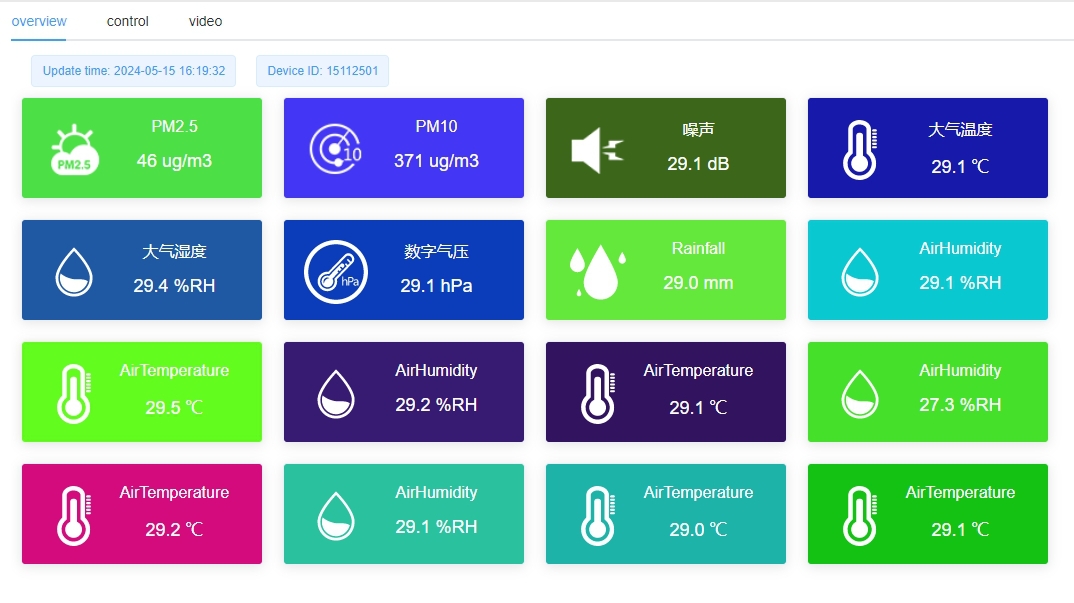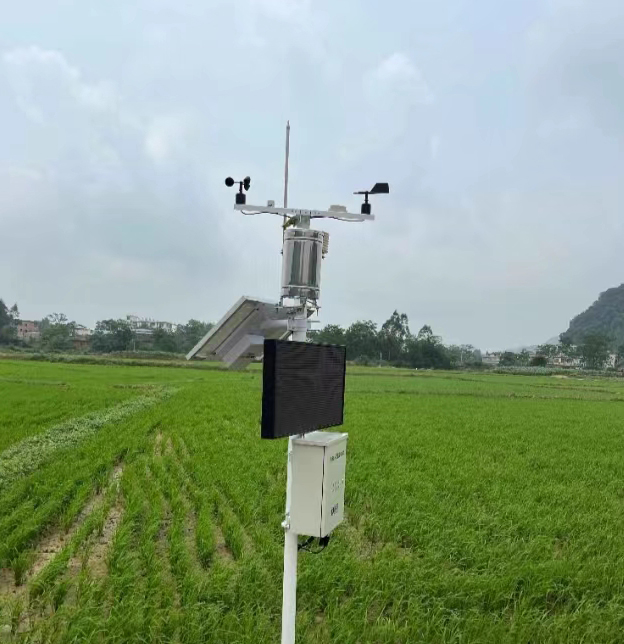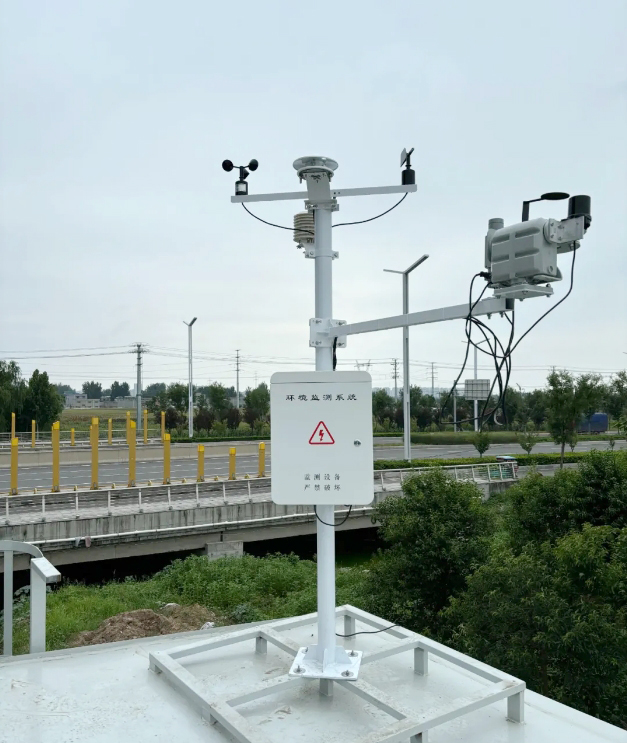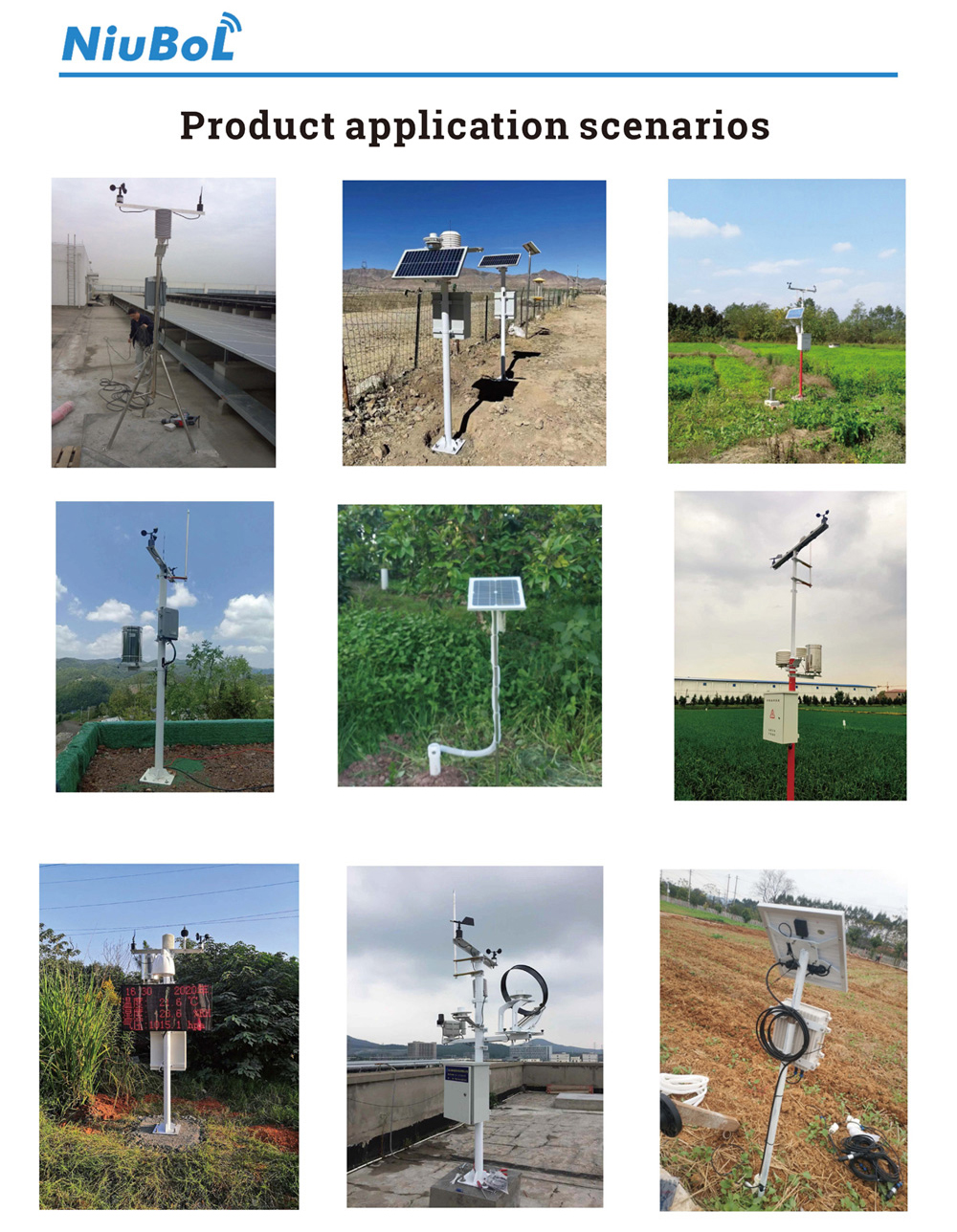

— Products —
 Consumer hotline +8618073152920
Consumer hotline +8618073152920 WhatsApp:+8615367865107
Address:Room 102, District D, Houhu Industrial Park, Yuelu District, Changsha City, Hunan Province, China
All products
Integrated weather station is a kind of monitoring system integrating a variety of weather sensors, specialized in measuring and recording environmental weather parameters, The main function of such equipment is to monitor and record key meteorological parameters such as temperature, humidity, wind speed, wind direction, air pressure, etc. in real time, providing important data support for weather forecasting, environmental monitoring, scientific research and decision making.
Tel/WhatsApp:+8615367865107
Email:Arvin@niubol.com +Nearly 100 partner company in more than 68 countries. We are committed to providing high-quality, practical products to meet your needs and help you solve problems.Product Details
Integrated weather station is a kind of monitoring system integrating a variety of weather sensors, specialized in measuring and recording environmental weather parameters, which is usually designed to be very compact and suitable for various environments, including urban, rural areas, remote areas and even outdoor activities. The main function of such equipment is to monitor and record key meteorological parameters such as temperature, humidity, wind speed, wind direction, air pressure, etc. in real time, providing important data support for weather forecasting, environmental monitoring, scientific research and decision making.
The following is a detailed introduction of the Comprehensive Weather Station, including its sensors, functional uses and main application scenarios.
 |  |  |  |  |
| Anemometer Wind Speed sensor | Wind direction sensor | Tipping bucket rain gauge sensor | Tipping bucket rain gauge sensor | Piezoelectric Rain Gauge |
 |  |  |  |  |
| Atmospheric Temperature Humidity air pressure Sensor | ultrasonic wind speed and direction sensor | 5 in1 Ultrasonic Weather Station Sensor | All-in-One Weather Station | 7 in1 Ultrasonic Weather Station Sensor |
 |  |  |  |  |
| Solar Radiation Sensor | Solar Radiation Sensor | Photosynthetically Active Radiation Sensor; | illumination sensor | Ultrasonic Snow Depth Sensor |
 |  |  |  |  |
| Noise measurement sensor | Carbon dioxide(CO2) sensor | PM2.5 and PM10 sensors | Visibility sensors | Soil Moisture Temperature sensor |
The core of a comprehensive weather station lies in its integrated sensors, which are capable of measuring multiple weather parameters at the same time to ensure the comprehensiveness and accuracy of the data. Below are some common sensors, their introduction and functional uses:
A temperature sensor is used to measure the air temperature and usually employs a thermistor or thermocouple as the sensing element. It can accurately reflect changes in air temperature, which is important for agricultural production, climate change research and other fields.
Humidity sensors are used to measure the relative humidity in the air, and the common types are capacitive and resistive. Humidity data is important for predicting weather changes and improving the living environment.
Barometric pressure sensors are used to measure atmospheric pressure, usually using piezoelectric or capacitive principles. Barometric pressure data is important for weather forecasting, aviation and navigation.
Wind speed sensors are used to measure wind speed and direction, and the common types are wind cup type, hot wire type and so on. The wind speed data is of reference value for wind power generation, building design and other fields.
Precipitation sensors are used to measure the amount of precipitation, mainly rain gauges and snow gauges. Precipitation data is important for flood prevention and disaster mitigation, water resource management, etc.
Determine the direction of the wind, which is helpful for weather forecasting, marine navigation and evaluation of wind power generation.
Measurement of solar radiation or UV intensity helps to understand the impact of solar activity on the earth's environment.
UV sensors are used to measure the intensity of ultraviolet rays, which helps to assess the impact of ultraviolet rays on the human body and the ecological environment, and to provide data support for sunscreen, radiation protection, and so on.
With no start-up wind speed limitation, these sensors provide accurate wind direction and wind speed data for a wide range of climatic conditions.
These sensors typically utilize high-precision technology and advanced measurement principles to ensure data accuracy and stability. They are also dust-proof, rain-proof and anti-interference resistant, and can adapt to a variety of harsh meteorological conditions and environmental requirements.
There are a number of other types of sensors in an integrated weather station in addition to those previously mentioned. The following is a detailed description of these additional sensors and their functional uses:
Introduction: used to measure solar radiation and light intensity, common light sensors are photoresistors and photodiodes.
Functional use: very important for the study of light conditions and hours of sunshine, help to understand the impact of solar activity on the Earth's environment, as well as provide data support for agricultural production, solar power generation and other fields.
Introduction: used to measure the moisture condition of soil, common soil moisture sensors are resistive soil moisture sensor and capacitive soil moisture sensor.
Functional use: important for agricultural production, soil research and other fields, helps farmers to understand the soil moisture status, so as to rationalize irrigation and fertilization management.
Introduction: Although not a sensor in the traditional sense, the data collector plays a vital role in the integrated weather station.
Functional use: It is responsible for collecting, processing and storing meteorological data measured by various sensors. It can convert the analog signals output from the sensors into digital signals and carry out preliminary processing and organization of data for subsequent transmission and analysis.
Air quality sensors: used to monitor the concentration of pollutants in the air, such as PM2.5, PM10, sulfur dioxide, nitrogen dioxide, etc., which helps to understand the air quality situation and provides a scientific basis for environmental protection and governance.
It is used to measure the visibility in the atmosphere, which is helpful for weather forecasting and traffic safety management.
Used to measure the evaporation rate of water surface or soil surface, which helps hydrological research and water resource management
Together, these sensors form the monitoring network of the comprehensive weather station, capable of monitoring and recording a wide range of meteorological parameters in real time, providing comprehensive and accurate meteorological data for various fields. With the continuous development of technology, more types of sensors are likely to appear in the future to meet the needs of different fields for meteorological data.

Data transmission and storage in an integrated weather station usually involves the following key steps and components:
- Wi-Fi/Network: Many integrated weather stations support Wi-Fi connectivity, which allows real-time data transmission to remote servers or cloud platforms.
- GPRS/3G/4G: In areas without Wi-Fi coverage, weather stations can use mobile networks to send data to designated servers.
- Satellite communication: in remote areas or mobile monitoring scenarios, the weather station may use satellite communication technology for data transmission.
- Ethernet: some weather stations provide Ethernet interfaces that can be connected to the data acquisition system via a wired network.
- Serial communication: data is transmitted to a computer or other device via a serial interface such as RS-232, RS-485, etc.

- Built-in storage: weather stations are usually equipped with built-in memory, such as SD card or solid state disk, for temporary storage of data.
- External storage device: external storage device can be connected via USB or other interface to save data.
- Cloud storage: Through wireless or wired network connection, the data can be uploaded to the cloud server in real time to realize remote storage and management of data.
- Data center: data can be transmitted to the data center of meteorological department or research institution for centralized storage and management.
- Real-time processing: Some weather stations can perform preliminary data processing locally, such as calibration, filtering, etc., before transmission.
- Data backup: In order to ensure data security, stored data are usually backed up to multiple locations on a regular basis, including local and remote backups.
- Encrypted Transmission: To protect the security of data during transmission, encryption protocols such as SSL/TLS are usually used.
- Access control: Access rights are set on the stored data to ensure that only authorized personnel can access and process the data.
Summarize
Data transmission and storage of comprehensive weather stations is a complex process involving a variety of technologies and methods. In order to ensure the accuracy, real-time and security of the data, weather stations usually use a combination of multiple transmission and storage means. With the development of IoT and big data technology, the data management and application of comprehensive weather station will become more efficient and intelligent.

Comprehensive weather station is widely used in various fields due to its comprehensive monitoring capability and high-precision data output:
Comprehensive weather station is an important tool for meteorological departments to carry out meteorological observation and forecasting, which helps to improve the accuracy of weather forecasting and provide data support for disaster prevention and mitigation.
Comprehensive weather station can be used to monitor air quality, ecological environment, etc., providing real-time data for the environmental protection department and helping environmental protection and pollution control.
Comprehensive weather stations provide data on soil moisture, light, temperature, etc. for agricultural production, which helps rationalize agricultural production and improve yield and quality.
Comprehensive meteorological stations provide key meteorological data such as wind speed, air pressure and temperature for aviation and navigation to ensure navigation safety.
The integrated weather station can monitor meteorological disasters in real time, such as typhoons, rainstorms, lightning, etc., and provide government departments with early warning information to reduce disaster losses.
The comprehensive weather station provides abundant meteorological data for scientific research organizations, which helps research in the fields of climate change and atmospheric science. At the same time, it can also be used for meteorological knowledge popularization and education training.

Summary
Comprehensive weather station is a multi-functional, high-precision, portable meteorological monitoring system that integrates a variety of sensors to collect and process meteorological data in real time. These data have a wide range of application value in the fields of meteorological monitoring, environmental protection, agricultural production, aviation and navigation, disaster early warning and so on. With the continuous development of the Internet of Things technology, the data transmission and processing capacity of the comprehensive weather station will be further improved, bringing more convenience and benefits to our life and work.
Sensors & Weather Stations Catalog
Agriculture Sensors and Weather Stations Catalog-NiuBoL.pdf
Weather Stations Catalog-NiuBoL.pdf
Related recommendations
 Multi-Depth Soil Sensor RS485
Multi-Depth Soil Sensor RS485 TDR Soil Moisture Sensor
TDR Soil Moisture Sensor Pyranometer Solar Radiation Sensors
Pyranometer Solar Radiation Sensors Soil ph sensor
Soil ph sensor Tipping Bucket Rain Gauge
Tipping Bucket Rain Gauge Air Temperature and Humidity Sensor
Air Temperature and Humidity Sensor
Screenshot, WhatsApp to identify the QR code
WhatsApp number:+8615367865107
(Click on WhatsApp to copy and add friends)